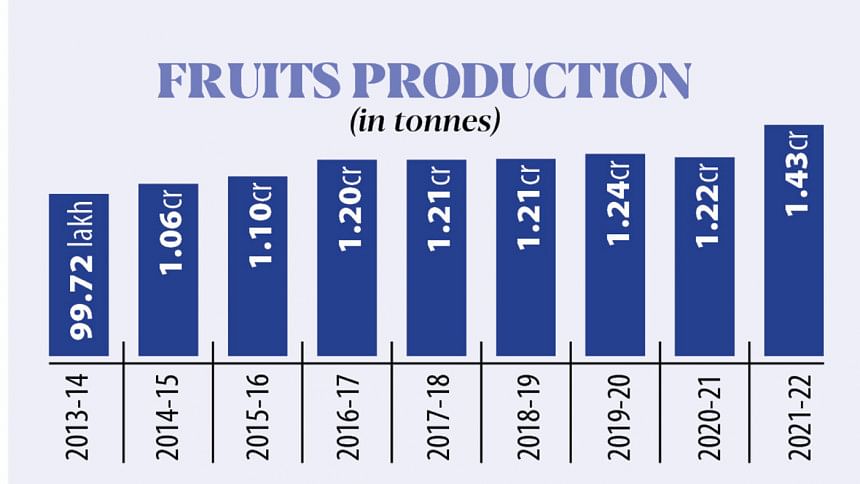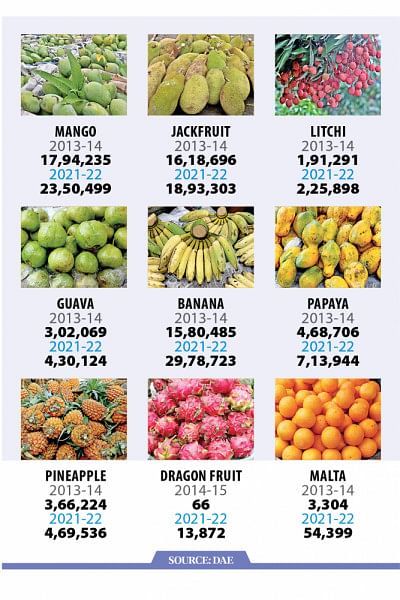Fruit Production: A silent revolution waged by farmers


There was a time when people grew orchards or fruit trees in homesteads primarily for their own consumption. But things have massively changed as farmers are turning to fruit production for its commercial viability.
Over the past two decades, fruit production in the country has seen a silent revolution due to the success of commercial farming.
Bangladesh is now among the ten largest tropical fruit-producing countries in the world and has been maintaining an 11.5 percent growth in fruit production on average for the past 18 years, according to the Food and Agriculture Organization (FAO) of the United Nations.
The sustained growth despite the limited availability of land has led to an average increase of per capita fruit intake to 85 grams in 2018 from 55 grams in 2006 for a massive population which now stands at around 170 million.
Commercial production of local fruits has increased substantially between 2013-14 and 2021-22. Especially remarkable in this period is the growth in mango, papaya, guava, banana and watermelon production.
Production of mango has hit its highest mark this year since the country's independence, say officials of Department of Agricultural Extension.
The country now holds the second position in annual jackfruit production, seventh in mango and eighth in guava production in the world, according to latest FAO estimates.
Besides, java plum (jaam), litchi, jujube, star fruit (kamranga), wood apple, lemon, pineapple, lotkon (Burmese grape), custard apple and sapodilla (safeda) are also included on the list of fruits being farmed on large scales.
Production of non-native fruits has also reached new heights to meet growing demands for strawberry, dragon fruit and malta.
"A silent revolution has taken place in fruit production. New areas like the Chattogram Hill Tracts have been included in commercial fruit production. We are even exporting fruits now. Foreign fruits like strawberry, rambutan and dragon fruit are also showing good prospects," Agriculture Minister Muhammad Abdur Razzaque told The Daily Star.
In addition to a gradual change in food habit towards a healthy diet, people's purchasing capacity has increased, according to agricultural experts. These factors have led to an increase in the demand for fruits, which explains why more and more farmers are showing an interest in fruit production, they say.
"Since rice as a staple food is not as profitable as it was, a large number of farmers have turned to fruit production. The farmers are using every conceivable space for cultivating fruits," said Sattar Mandal, former vice chancellor of Bangladesh Agriculture University.
Soil condition is also favourable for the cultivation of foreign fruits like malta, strawberry and dragon fruits, he said.
Even a decade ago, most of the local fruits were available for only three months during the hot and humid summer. People eagerly waited for May, June, and July when mango, litchi, jackfruit and the other tropical fruits would appear in markets.
The scene has changed, however. Several fruits are found year-round.
"Fruits are not only available for three months now. We can have guava, banana, papaya and some other fruits round the year. Besides, due to the introduction of early and late varieties of mango, we are trying to create an opportunity to have the popular fruit throughout the year," said Mehedi Masood, the Project Director of the Year-Round Fruit Production for Nutrition Improvement Project.
The goal of the project is to make fruits available round the year and meet the nutrition demand of the population, Masood told The Daily Star, adding that the DAE has been implementing it since 2014-15.
He said that progress has been made in increasing per capita fruit consumption.
"But there is still a long way to go in attaining the ideal consumption of 250 grams of fruit daily for adults," he said.
Since the inception of the project, over 1.77 lakh farmers have been given training in fruit cultivation through the horticulture centres, DAE officials said.
Besides, over 47 lakh fruit trees were planted across the country during this period.
According to the DAE, in the 2006-07 fiscal year, fruits were cultivated on 4.74 lakh hectares of land and the yield was 87.86 lakh tonnes.
In 2021-22 FY, agricultural land for fruit farming has jumped to 7.34 lakh hectares and fruit production to 1.43 crore tonnes.
"Due to changes in weather patterns, we are having longer spells of summer. The change is conducive to growing more tropical fruits round the year," said Mandal.
The agricultural minister, however, said that fruit storage is still a big challenge and that's why the government is focusing on setting up multipurpose cold storage facilities across the country under a project called Programme on Agricultural and Rural Transformation for Nutrition, Entrepreneurship, and Resilience in Bangladesh (PARTNER).
"We are also encouraging scientists to find out the way how the shelf life of the fruits can be expanded," said the minister.
Meanwhile, Masood said that they have taken an initiative for dried jackfruit, mango and pineapple so that those can be consumed later.
According to the agriculture ministry, the number of fruit varieties cultivated in Bangladesh has increased from 56 a decade ago to 72 now.

 For all latest news, follow The Daily Star's Google News channel.
For all latest news, follow The Daily Star's Google News channel. 



Comments